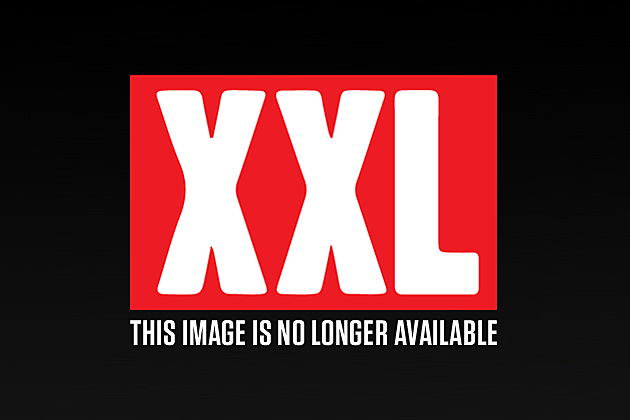
FEATURE: Clans, Posses, Crews & Cliques
If Jay-Z is in the third act of his career as a rapper—the one where his mere appearance in proximity to a microphone is cause for adulation, celebration and genuflection—then the second and most enduring part of his tale began around 1998, with the release of Vol. 2... Hard Knock Life, an album that would sell over five million records within U.S. borders alone. The album not only made Jay a household name beyond the hood, it marked the ascension of his Roc-A-Fella Records and, moreover, pushed the idea of his organization to the forefront of our consciousnesses. No longer were we to think of Jay-Z in the singular. He now represented an entity—a crew, The Roc—whose presence in any given house or building was established by his voice or by his logo: a black-and-white Champagne bottle with a huge R, backed by a vinyl record.
The time was right. Death Row’s steamroller momentum had ground to a halt after the death of Tupac Shakur and the departure of Dr. Dre. Likewise, Bad Boy was on a downswing, following the loss of the Notorious B.I.G. and the retirement (later rescinded) of its next-most-valuable asset, Ma$e. Master P’s No Limit, for all its laudable accomplishments, had never risen above regional-novelty status—the No Limit Army may have occupied the South, but the world was still for the taking. On the strength of hits like “Hard Knock Life,” “Money, Cash, Hoes” and “Can I Get a…,” Jay-Z was suddenly the biggest star in rap, primed to cement his spot by making Roc-A-Fella seem like an all-powerful juggernaut.
Of course, Jay-Z did not invent the idea of a rap crew. The notion of the posse is almost as integral to hip-hop as is that of the DJ. As the stories go, MCing, as we know it today, began with orators grabbing the mic to shout out their peers in the crowd at DJ Kool Herc’s parties in 1970s Bronx. (Herc’s cronies, the Herculords, were an early, proto-hip-hop crew.) And, in terms of blueprint, the early days of hip-hop coincided with the rise of The Universal Zulu Nation, which was borne largely from the notorious Black Spades and other gangs that ruled the Bronx River Houses.
But the modern idea of a crew—an assortment of rappers not only bound together by loyalty and a common goal but operating under a single aegis, like a house of nobles—can be traced directly to the late ’80s and N.Y.’s Juice Crew, the first crew to gain national acceptance and still, in certain circles, the most revered of them all. Spearheaded by 107.5 WBLS radio jock Mr. Magic (a.k.a. Sir Juice) and seminal producer Marley Marl and home to groundbreaking female rapper Roxanne Shanté, beloved clown prince Biz Markie and two legitimate “Top Five Dead or Alive” candidates, in Big Daddy Kane and Kool G Rap, the Juice Crew set the standard for hip-hop excellence in its day and had a lasting impact that can’t be understated. Practically every crew, collective or “movement” since—from the Wu-Tang Clan to DJ Khaled’s “We the best!” posse-cut regulars—is indebted to the Queensbridge Houses–based squad.
By the mid-’90s, it was almost a prerequisite for newly signed MCs to unveil their audacious plans for world domination: the artists they’d signed to the labels they were launching, the reason why said newly signed MC would be able to kick his feet up and retire to an executive suite within a few short years. A decade before technology allowed for full-on crew mixtapes as an introduction to the extended family, there was the posse cut, all but invariably buried near the final third of an album, a showcase for the forthcoming talent. But this approach was sloppy reverse engineering of a working model. The Juice Crew was not successful because of the power of any one person whose coattails were ridden to fame. In fact, the group’s earliest star, MC Shan, did not even appear on its defining moment, “The Symphony,” deeming his would-be co-stars as unworthy new jacks.
It’s temptingly simple to base the existence of rap’s so-called golden era around the activities of one group, but, at the same time that the Juice Crew was creating history, Eazy-E, a young drug dealer from Compton, California, was putting together an organization that would go on to be known as “the world’s most dangerous group.” While not a crew, per se (more of a supergroup, really), N.W.A served as the nucleus of a collective that would go on to be just as important to the rap world as the Juice Crew. The similarities between the two are as important as the distinctions. There was the nexus of sound provided by a singular source (in this case, the tandem of Dr. Dre and DJ Yella), the ghostwriters/stars in their own right (MC Ren, Ice Cube and The D.O.C.), and the legacy (the echoes of Dr. Dre’s soundscape still sound throughout Cali to this day, and Ice Cube remains one of the weightiest names in the genre). Not only did N.W.A write the rule book for modern gangsta rap, they also added the element of acute business sense into the mix. Eazy-E’s vision included Ruthless Records, an artist-owned label that spawned novelty act J.J. Fad and R&B flash in the pan Michel’le, while setting up the main N.W.A members as solo stars. Unfortunately, it was this same business sense that led to the demise of the crew. Cube soon left, amid monetary disputes, forming his own Lench Mob Records. Dre then followed suit, to become the guiding force behind Death Row.
N.W.A’s breakup gave light to a lie that continues to proliferate even now: the idea that crews are indestructible. For all the declarations of “for life ’til death,” no crew in history has avoided splits, defections and strange bedfellows. The most loyal members have been excommunicated; the closest friends have traded harsh jabs, subliminal digs and snide comments; the most prominent tattoos have had their meanings re-contextualized.
The heavier involvement of the industry has complicated affairs. As hip-hop proved itself to be a lucrative investment (N.W.A sold nearly two million records without commercial airplay or a major ad campaign), the idea of the crew became much more important to record labels looking to cash in. First and foremost, the artist-to-artist co-sign provided a built-in scouting system for A&R departments, which hardly knew what they were looking for, much less where to find it. As Afrocentrism arose as the yang to gangsta rap’s yin, the Native Tongues family represented the fullest flowering of hip-hop’s potential for peace, harmony and one-for-all, all-for-one umoja. This even as their members—A Tribe Called Quest, De La Soul, Queen Latifah, Jungle Brothers, Black Sheep, et al.—were spread among various recording houses. Though they were joined by the specific aesthetic that would later go on to be termed “conscious,” each act had its own unique sound and marketing plan. This allowed several albums—De La’s 3 Feet High and Rising, JB’s Done by the Forces of Nature and Latifah’s All Hail the Queen—to be released in the same year, 1989, with ATCQ’s People’s Instinctive Travels and the Paths of Rhythm following in the next. The Tongues were able to maximize their presence while labels minimized their risk.
In today’s game, labels are as cautious as ever of their bottom line but much more adept at manufacturing stars and presenting them to the public. Moreover, aspiring acts are themselves able to break into the big leagues without an established sponsor, due to technological advancements most obvious in the role the Internet plays in current rap marketing (as Soulja Boy tells us). For those with drive and ambition, it’s no longer necessary to play the background of a charitable benefactor. The quick-gain mentality of contemporary rappers—accompanied by the notion that record sales are drying up—means less tolerance for gatekeepers. (A notable example of the phenomenon came in the acrimonious departure of hook specialist and Diplomats affiliate Max B., who insisted that he too was a “boss” and that Dipset capo Jim Jones was holding him back.)
Tellingly, the age of record deal by affiliation produced some of the most formidable crews in hip-hop: those able to weather storms, break away and regroup. There was EPMD’s Hit Squad—consisting of EPMD’s Erick Sermon and Parrish Smith, Redman, Keith Murray, Das EFX, K-Solo and others—flowing almost exclusively over Sermon’s thick funk grooves. (Like N.W.A, the Hit Squad disbanded over fiduciary infidelity, with Sermon’s crew becoming the Def Squad, and Smith’s followers becoming known as The Squadron.) Brooklyn’s Boot Camp Clik—Black Moon, Smif N’ Wessun, Heltah Skeltah, Originoo Gunn Clappaz and the production team Da Beatminerz—started their own label, Duck Down Records, and took the concept of collectivism as seriously as anyone: military-based ranking order, a uniform that allowed only Timberland boots as footwear, a strict refusal of traditional spelling. It was O.G.C.’s Starang who laid down one of the most succinct declarations of crew mentality ever heard on wax, when, on 1996’s “Hurricane Starang,” he rhymed, “I’m Duck Down staff even when I’m by myself/I’m Boot Camp Clik even when I’m by myself/I’m Fab 5 even when I’m by myself/I’m O.G.C. even when I’m by myself.”
At its best, the crew dynamic was the inverse of an army of one. It was one of extended self, an expression of vetted existentialism that gave coded voice to sentiments not openly spoken. Behind the manifestation of crew was the idea that no man was an island, that non-blood-brothers could show love for, and reliance upon, one another, without lessening themselves—that these bonds, in fact, fostered their greatest achievement and could even extend beyond the cipher to the public. For listeners, pledging allegiance to a crew was not about following a cult leader; it was about joining a cause, enlisting in a force that reflected a specific worldview, with the implied promise that we too could be a part of something bigger, better, beyond ourselves.-Kris Ex
For more of the Clans, Posses, Crews & Cliques Interview make sure to pick up XXL’s March issue on newsstands now.
More From XXL









